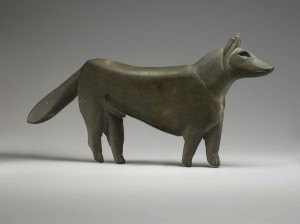Downstairs in the Metropolitan’s very modern Lehman donut there is a fascinating exhibition of early Egyptian art. It traces what scholars currently deduce about the evolution of that art as revealed by “predynastic” finds from 4,400 BC (roughly six thousand years ago) though to the establishment of a fully ordered wealthy and profoundly hierarchical society, c. 2650 BC.
It starts with lumpish clay daubs, clumsy amulets, simple pots—all clearly magic objects posited to invoke control over an uneven world. To live meant subduing threats from animals—especially the hippos and crocodiles that were particularly prevalent along the shores of the Nile. Hunting for fish, small game, or birds wasn’t the problem that competing for space and access with these aggressive, dangerous and large creatures would have been.

Art had a function: To enhance any desperate measures to invoke control– quite possibly a different purpose from whatever drove creation of those shockingly sophisticated images by artists in the caves of southern Europe some 40,000 years earlier.
Or it seems so from their technique alone.
This exhibit is arranged to show development of improved communal ritual as Egyptian command over nature improved, as technologies developed, as wealth was created.
Social purposes, mysterious only because the actual practices of protection, healing, honoring or placating the dead, aren’t clear to scholars yet. And might never be.
But the reason for the art is unmistakable: It is holding society together.
And society did progress. Elephants disappeared from the animal iconography; they had ceased to live in Egypt. Ducks, turtles, ibis, snakes came to function perhaps first as counting figures, with rows quickly painted on clay pots. Commerce is rising out of barter. One needs to keep ccount. These then came to be true hieroglyphs marrying images to the function of increasingly complex records: poetry, history. As society grew, art organized the traditional forms that ensured traditional forms.

By the end of the exhibition there were cities with ordered classes all along the Nile, and time-honored schemes of representation. Most famously, of course, the classic figure painting with feet and legs positioned sideways, chest and torso twisted to the front so both arms are free for action, head dutifully in profile. This motif shows up first almost as an improvisation, sketch, sketch, to show action without omitting a limb. Brush on clay. It was refined and specialized over long periods of time.
Egyptian dynastic society has turned out to be one of the most steady over time human history has seen.
The Metropolitan was kind enough to give permission for use of the images here. Many are borrowed, including “Bird Woman” –she with the lyrical hips and the rounded horn-like arms raised in ecstatic celebration, usually on display in the Brooklyn Museum.
She is quite tiny, and of a type. Several including male figures are here. Scholars say the beak-head is actually an enlarged nose. Burial figures of this era had to be equipped to breathe in a tomb. Everything without a function is omitted. The legs fold together in a single point in order to fit into a holder.
My visit to this show ended with a walk back up the steps of the Lehman to get out.
There, at the head of the stairs, is Balthus’ painting of a girl facing a fireplace mantle. 1955. How much this composition owes to classical Egyptian modes! The feet in unreal alignment, turned symmetrically left, the chiseled body forms, the timeless, static “hold” of the whole. And how completely different in its reason for being.
Here is no obvious ritual for defense or control. No support for society’s foundations. If this painting has a function it might be to disarm or control the large and dangerous animals of our ids. But maybe that’s a psychobabble stretch. This work of art is perverse and deliberately disruptive. It intends to tramp on taboos. Here is a frank appeal to pedophilia, to Humbert-Humbert style desire for the floppy unformed sexuality of a twelve-year-old, too young to have a real female body, who serenely pleasures herself with her adult hair and measures herself in a mirror –an image we viewers cannot see–while a blue beak-like pitcher on the mantle measures her. Something like the first image in this post?

Why do I love this painting? Is this what I need art to do?
And what does this have to do with the purpose of art as currently practiced by a small percent of the 1%. The feat of spending millions of dollars for a single pastel drawing?
Actually, we understand it well enough: owning an item that has become a cultural icon (by whatever means) is “worth it” because it reveals to all that the owner has the money to do it. Artists like Koons and Hurst simply cut to the chase (as good artists can do) and create instant cultural icons made of money. Or diamonds, locomotives….or cheesy plastic flowers.
The function for the rest of us though…is what?
